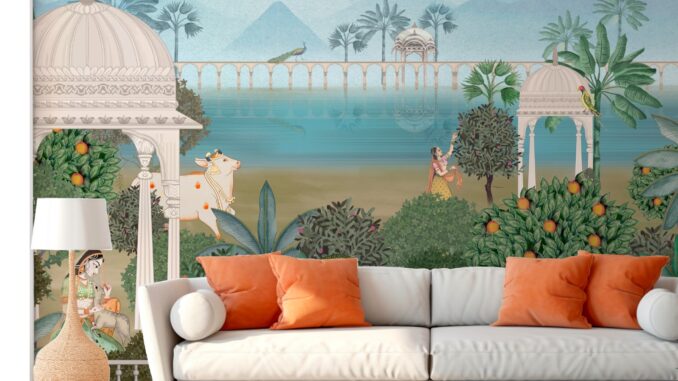
Pichwai is a traditional Indian art form from Rajasthan, closely tied to the temples of Nathdwara. The term “Pichwai” means “behind the painting,” referring to the large, ornate artworks or textiles once hung behind idols in temples, often depicting scenes from Lord Krishna’s life.
Pichwai art is a part of India’s rich culture and heritage, preserving traditions and stories through beautiful artwork. These paintings originally were used as a backdrop of lord Krishna temples. They were intended to narrate the series of Krishna Leela thru this art.
In contemporary homes, Pichwai artworks are frequently arranged in vertical clusters near architectural features such as doorways, reflecting a modern adaptation of their traditional display. Historically, these large-format textile works were prominently installed in expansive havelis, underscoring their original ritual function and monumental scale.
Today, a significant number of collectors acquire Pichwais specifically for personal shrines or mandirs, often commissioning bespoke pieces tailored to the dimensions of the idol and the architectural parameters of the sacred space. This practice not only affirms the continued devotional relevance of the art form but also highlights its inherent versatility and capacity for contextual adaptation.
Pichwai, often used as a wall hanging, brings a cultural or devotional narrative to the interior spaces. A floor-to-ceiling Pichwai painting adds rustic appeal to the space while narrating the story of Palitana, rooted in Jain mythology. You can also incorporate antique Pichwai paintings as statement pieces in our projects, some of which feature real gold detailing, and they also contribute to the overall value of the property.
When hung with a creative eye, Pichwai art can transform entirely. For those with older works at home who feel fatigued by seeing them in the same context, a simple act of reframing, perhaps breaking away from the expected gold-gilded or wooden frames, can reinvigorate both the artwork and the space it inhabits. Just because the form is traditional does not necessarily mean the presentation must be.
A key curatorial recommendation is the installation of a large-scale Pichwai painting within narrow transitional spaces such as foyers or corridors—areas often perceived as unsuitable for monumental works. Contrary to this assumption, such settings can in fact enhance the experiential quality of Pichwai art.
Owing to its characteristic intricacy and dense iconographic detailing, the proximity afforded by confined architectural spaces facilitates a more intimate visual engagement. In these contexts, the artwork assumes an almost mural-like presence, inviting close inspection and sustained appreciation by the viewer, thereby transforming the corridor into a site of aesthetic encounter.
Simultaneously, in expansive farmhouses or double-height interiors, larger Pichwai works are especially well-suited to accentuating and harmonising with the scale and spatial grandeur of such environments, further illustrating the art form’s exceptional adaptability. As previously noted, when employing a clustered format, the configuration may be creatively dispersed. For example, in cases where a central piece of furniture is flanked by two adjoining walls, one might opt to display a balanced arrangement, such as four panels on each side, thereby achieving both visual symmetry and contextual coherence.
Read the full story that first appeared in Luxury Facts here:


Leave a Reply